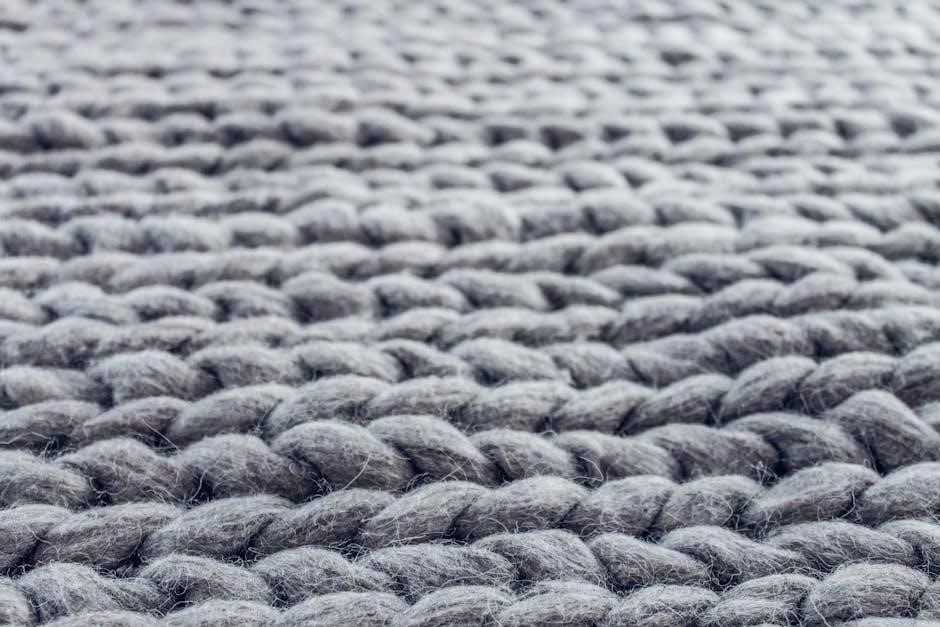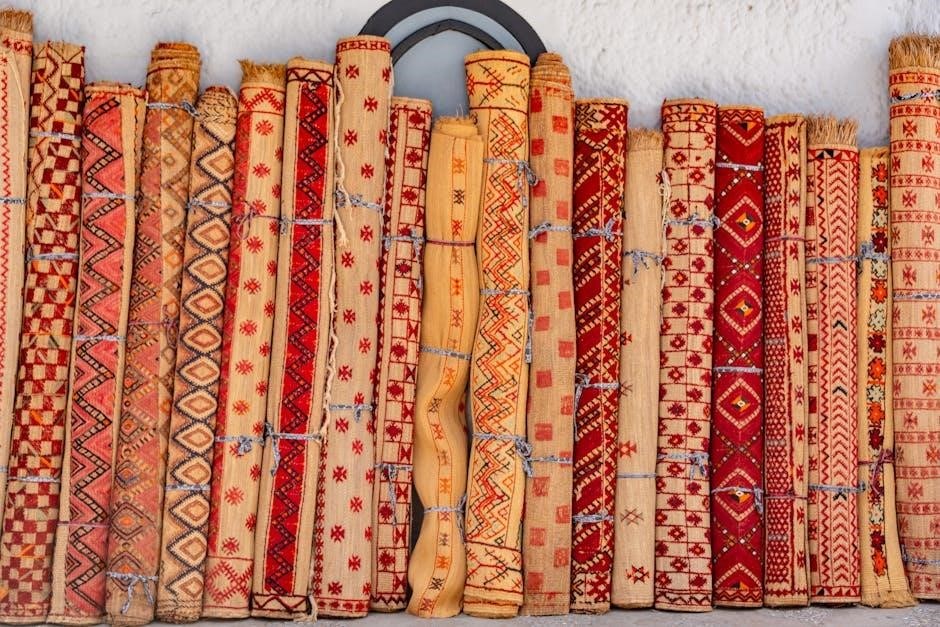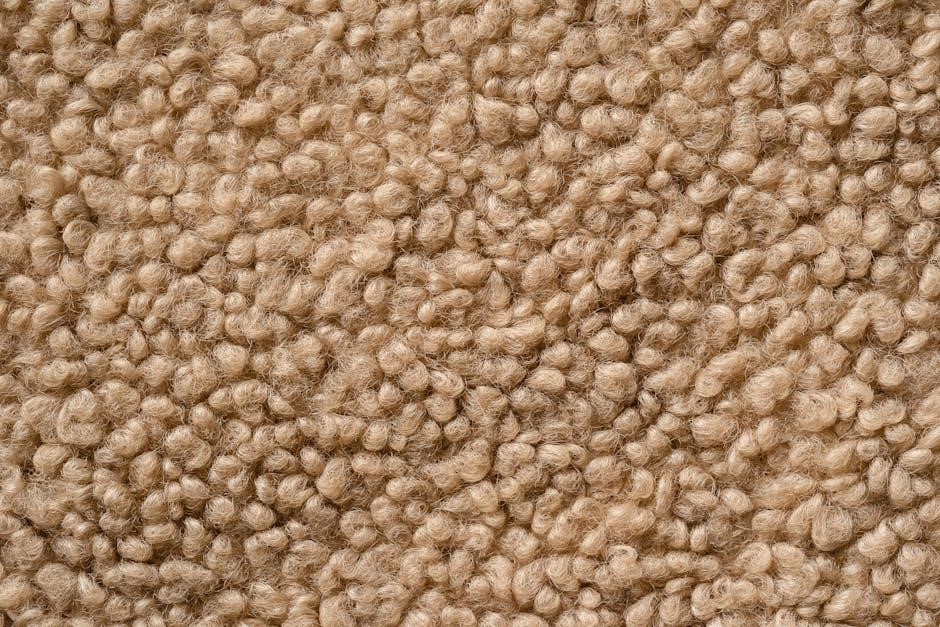Jelly Roll Rug Pattern PDF Free: A Comprehensive Guide
Dive into the cozy world of jelly roll rugs! This comprehensive guide helps you discover free PDF patterns, unlocking a creative sewing journey. Learn to transform fabric strips into beautiful, functional rugs. Find tutorials and inspiration to craft unique rugs!
What is a Jelly Roll Rug?
A jelly roll rug is a unique and charming creation made from fabric strips, typically 2.5 inches wide, sewn together and wrapped around batting to form a sturdy and decorative rug. The name “jelly roll” comes from the pre-cut fabric bundles, resembling a rolled-up jelly roll cake, that are often used in their construction.
These rugs are not only visually appealing but also practical, adding a touch of handmade warmth to any room. They are perfect for entryways, kitchens, bathrooms, or even as bedside rugs. Their versatility extends to customization, allowing you to choose fabrics that match your home decor or reflect your personal style.
Jelly roll rugs offer a fantastic way to utilize fabric scraps or showcase favorite fabric collections. The construction process involves sewing the jelly roll strips end-to-end, creating a long continuous piece. This strip is then wrapped around batting and sewn together in a spiral, resulting in a durable and eye-catching rug. The technique is accessible to both beginner and experienced sewists, making it a popular project among quilting enthusiasts.
Materials Needed for a Jelly Roll Rug
Creating a jelly roll rug requires a few key materials to ensure a successful and beautiful finished product. First, you’ll need a jelly roll, which is a bundle of 2.5-inch wide fabric strips. Alternatively, you can cut your own strips from your fabric stash, ensuring they are all the same width for a consistent look.
Next, you’ll need batting, which provides the rug’s structure and cushioning. Pre-cut batting rolls are available, or you can cut your own batting strips to the desired width. Coordinating thread is essential for seamlessly sewing the fabric and batting together, adding to the rug’s overall aesthetic.
Beyond these basics, a sewing machine in good working order is crucial for efficient and accurate stitching. A walking foot can be particularly helpful for evenly feeding the layers of fabric and batting through the machine. Additional tools include a rotary cutter, cutting mat, and ruler for precise fabric preparation, as well as scissors, pins, and an iron for pressing seams and ensuring a professional finish. With these materials in hand, you’ll be well-equipped to embark on your jelly roll rug adventure.
Preparing the Jelly Roll Strips
Preparing your jelly roll strips is a crucial step in creating a stunning jelly roll rug. Begin by carefully unrolling your jelly roll and admiring the array of colors and patterns you’ll be working with. Next, take each strip and iron it to remove any creases or folds, ensuring a smooth surface for sewing. This step is essential for achieving a professional-looking finish.
Once your strips are ironed, it’s time to sew them together end-to-end to create one continuous length of fabric. This long strip will form the foundation of your rug, so it’s important to sew the seams securely. Use a straight stitch and a consistent seam allowance, typically 1/4 inch, to maintain a uniform width throughout the strip.
As you sew the strips together, consider the placement of colors and patterns to achieve your desired aesthetic. You can create a random mix or arrange the strips in a specific order for a more planned design. After sewing all the strips together, press the seams open to reduce bulk and ensure a flat, even surface. With your jelly roll strips prepared, you’re ready to move on to the next stage of your jelly roll rug project.

Batting Options for Jelly Roll Rugs
Choosing the right batting is essential for creating a jelly roll rug that is both durable and comfortable. Several batting options are available, each offering unique characteristics to suit different preferences and needs. Precut batting rolls, specifically designed for jelly roll rugs, provide convenience and uniformity. These rolls eliminate the need for cutting individual strips, saving time and ensuring consistent width.
Alternatively, you can cut your own batting strips from batting yardage. This option allows for greater customization, enabling you to select your preferred batting type and thickness. Consider using cotton batting for its softness, breathability, and natural fibers. Cotton batting is also relatively easy to work with and provides a good balance of cushioning and stability.
Polyester batting is another popular choice, offering excellent durability and resistance to shrinking or stretching. It is also hypoallergenic and easy to care for, making it a practical option for rugs that will be used frequently. Fusible batting can also be considered, this helps in stabilising the fabric. Ultimately, the best batting option depends on your personal preferences and the desired characteristics of your finished jelly roll rug.
Sewing the Batting into the Jelly Roll Strips
Once you’ve prepared your jelly roll strips and chosen your batting, the next step is to encase the batting within the fabric. Begin by laying a batting strip centered on the wrong side of a fabric strip. Ensure the batting extends evenly along the length of the fabric.
Next, fold one long edge of the fabric strip over the batting, pressing gently to secure it in place. Repeat this process with the opposite long edge, overlapping the folded edges slightly to fully enclose the batting. This creates a neat, finished edge along both sides of the strip.
Now, fold the entire strip in half lengthwise, concealing the raw edges inside the fold. Press the fold to create a crisp, clean line. This step effectively sandwiches the batting between the two layers of fabric, creating a padded strip ready for rug construction. Consistent folding and pressing are crucial for achieving a professional-looking finish and ensuring the rug lies flat; Take your time with this process.
Basic Jelly Roll Rug Construction Techniques

The core of jelly roll rug construction involves a continuous spiral technique. Begin by coiling the end of your prepared jelly roll strip into a small circle. Secure the starting point with pins or clips to prevent unraveling. Using a wide zigzag stitch on your sewing machine, carefully stitch the edges of the coil together.
As you continue to coil, maintain a consistent tension to ensure the rug remains flat. Gradually increase the size of the spiral, aligning the edges of the strip and stitching them together with the zigzag stitch. The key is to keep the edges butted closely against each other to avoid gaps.
Periodically pause to flatten the rug and check for any puckering or unevenness. Adjust your tension or stitch width as needed to maintain a smooth, even surface. Continue this process until you reach the desired rug size, securing the final end of the strip neatly. With patience and careful stitching, you’ll create a beautiful and durable jelly roll rug.

Free Jelly Roll Rug Patterns and Tutorials Online
The internet offers a treasure trove of free jelly roll rug patterns and tutorials for quilting enthusiasts of all skill levels. Numerous websites and blogs provide downloadable PDF patterns, guiding you through each step of the construction process. These patterns often include detailed instructions, diagrams, and even video demonstrations.
Platforms like Pinterest and YouTube are excellent resources for discovering a wide variety of free tutorials. Many experienced quilters share their techniques and tips, offering valuable insights into creating stunning jelly roll rugs. Look for tutorials that provide clear visual guidance and address common challenges.
Several fabric retailers and quilting supply stores also offer free patterns as a way to showcase their products and inspire creativity. Explore their websites and sign up for newsletters to stay informed about new free patterns and promotions. With a little searching, you’ll find a wealth of free resources to embark on your jelly roll rug adventure.
Customizing Your Jelly Roll Rug Design

One of the joys of creating a jelly roll rug is the ability to customize the design to perfectly match your personal style and home décor. The possibilities are endless, allowing you to express your creativity and create a truly unique piece.
Fabric selection is key to achieving the desired look. Experiment with different color combinations, patterns, and textures. Consider using a jelly roll that features a specific theme or color palette, or mix and match strips from various collections to create a more eclectic design.
Beyond fabric, you can also customize the shape and size of your rug. While round and oval rugs are the most common, you can explore other geometric shapes or even create free-form designs. Adjusting the number of jelly roll strips and the width of the batting will allow you to create rugs of various sizes, from small placemats to large area rugs.
Adding embellishments, such as fringe, tassels, or decorative stitching, can further enhance the unique character of your jelly roll rug.
Jelly Roll Rug Sizes and Dimensions
Jelly roll rugs are wonderfully versatile, and their sizes can be easily adapted to suit your specific needs and preferences. The final dimensions of your rug will primarily depend on the number of jelly roll strips you use and the width you choose for your batting.
A standard jelly roll, containing 40 strips, will typically yield a rug that measures approximately 30 inches by 44 inches. However, this is just a guideline. Using more strips will naturally result in a larger rug, while using fewer strips will create a smaller one.
For smaller projects, such as placemats or small mats, consider using a mini jelly roll or simply cutting down the number of strips from a regular jelly roll. Conversely, for larger area rugs, you may need to combine multiple jelly rolls to achieve the desired size.
Remember to factor in the thickness of the batting when calculating your final dimensions, as this will also affect the overall size of the rug. Experiment with different batting widths to achieve the desired level of thickness and texture.
Tips for Sewing a Flat Jelly Roll Rug
Achieving a perfectly flat jelly roll rug requires attention to detail and consistent technique. Here are some essential tips to ensure your rug lies flat and doesn’t buckle or warp.
Consistent Seam Allowance: Maintain a consistent seam allowance throughout the entire project. This ensures even distribution of fabric and batting, preventing puckering.
Ironing is Key: Press each row thoroughly after sewing. This helps to flatten the seams and set the fabric, contributing to a smoother finish.
Even Tension: Keep your sewing machine tension balanced. Uneven tension can cause the fabric to pull or stretch, leading to a warped rug. Test your tension on a scrap piece first.
Walking Foot: Use a walking foot on your sewing machine. This foot helps to feed the multiple layers of fabric and batting evenly, preventing shifting and distortion.
Gentle Curves: When curving the rug, do so gradually and evenly. Avoid sharp turns that can create bunching and unevenness.
Take Breaks: Sewing a jelly roll rug can be time-consuming. Take regular breaks to prevent fatigue, which can lead to errors and inconsistencies.
Troubleshooting Common Jelly Roll Rug Issues
Creating a jelly roll rug can sometimes present challenges. Here’s a guide to troubleshooting common issues and finding effective solutions.
Rug is Wavy or Buckling: This often results from inconsistent seam allowances or uneven tension. Ensure a consistent seam allowance and adjust your machine’s tension. Ironing each row can also help flatten the rug.
Seams are Puckering: Puckering can occur if the fabric is being pulled too tightly during sewing. Loosen your tension slightly and use a walking foot to feed the fabric evenly.
Batting is Shifting: Secure the batting within the fabric strip by carefully folding and pressing. Using a fusible batting can also help keep it in place.
Difficulty Turning: Turning the rug can be challenging. Slow down and gently ease the fabric around the curve. Smaller stitches can provide more control.
Rug is Not Lying Flat: If the rug is not lying flat, ensure that all seams are pressed open and flat. Blocking the rug after completion can also help it to lay flat.
Fabric is Fraying: Use a rotary cutter and mat for precise cuts to minimize fraying. Consider using a fabric with a tighter weave.
Alternative Jelly Roll Rug Shapes
While the traditional jelly roll rug is often round or oval, you can explore various shapes to create unique and eye-catching designs. Experimenting with different forms adds a personalized touch to your crafting projects.
Oval Rugs: An oval rug is a classic variation, providing a slightly elongated shape. You can easily adjust the length of the starting strip to achieve the desired oval dimensions.
Rectangular Rugs: For a more structured look, create a rectangular rug by sewing straight strips and making sharp turns at the corners. This shape is ideal for entryways or hallways.
Square Rugs: Similar to rectangular rugs, square rugs offer a balanced and symmetrical design. They work well in smaller spaces or as accent pieces.
Hexagonal Rugs: For a bolder geometric statement, try a hexagonal rug. This requires careful planning and precise angles, but the result is a stunning, modern piece.
Freeform Shapes: Let your creativity flow and design a rug with an irregular or freeform shape. This allows for unique and artistic expressions, making each rug truly one-of-a-kind.
Heart-Shaped Rugs: Ideal for adding a touch of whimsy, a heart-shaped rug is perfect for nurseries or children’s rooms. The curves add a playful element.
Caring for Your Finished Jelly Roll Rug
Proper care ensures your jelly roll rug remains vibrant and durable. Regular maintenance will prolong its life, keeping it a cherished part of your home decor.
Vacuuming: Regularly vacuum your rug to remove dust and debris. Use a low-power setting to avoid damaging the fabric or seams. A handheld vacuum is ideal for smaller rugs.
Spot Cleaning: Address spills and stains promptly with a mild detergent and a damp cloth. Gently blot the affected area, avoiding harsh scrubbing that can distort the fibers.
Washing: If necessary, hand-wash your rug in cold water with a gentle detergent. Avoid machine washing, as the agitation can damage the rug’s structure.
Drying: Lay the rug flat to air dry, away from direct sunlight. This prevents shrinking and fading. Ensure the rug is completely dry before placing it back on the floor.
Rotating: Rotate your rug periodically to distribute wear evenly. This prevents certain areas from becoming overly worn or faded.
Storage: If storing your rug, roll it up carefully and wrap it in a breathable fabric to protect it from dust and moisture. Avoid folding, as this can create creases.
Professional Cleaning: For deep cleaning, consider professional rug cleaning services. They have the expertise and equipment to safely clean and restore your jelly roll rug.